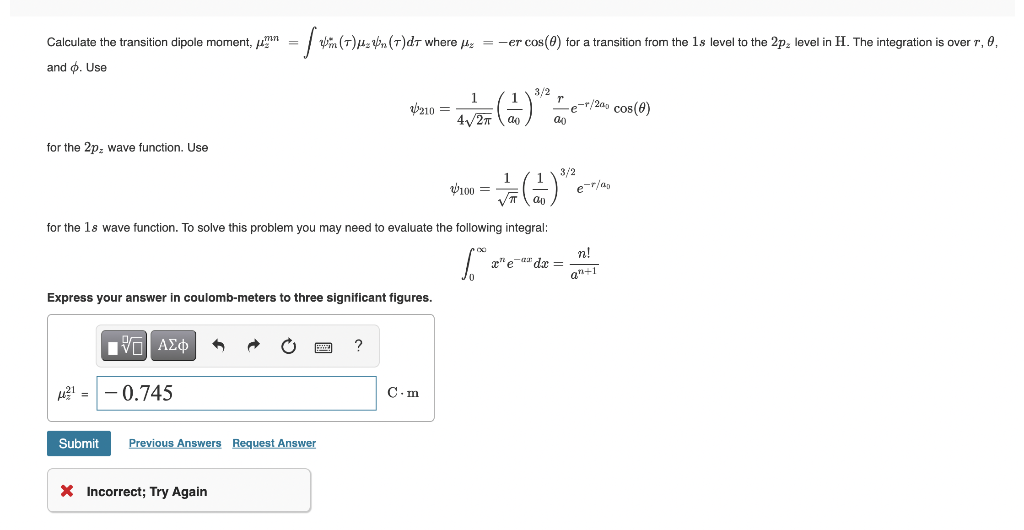Calculate the transition dipole moment, umn = | m (T)Hz n (T)dT where uz = -er cos(0) for a transition from the ls level to the 2p, level in H. The integration is over r, 0, and 6. Use 3/2 b210 = er/2a9 cos(e) 4/27 ao for the 2p; wave function. Use 3/2 W100 = e-r/as for the 1s wave function. To solve this problem you may need to evaluate the following integral: n! g"e-a" de = Express your answer in coulomb-meters to three significant figures. ινα Αφ ? -0.745 C- m Submit Previous Answers Request Answer X Incorrect; Try Again
Calculate the transition dipole moment, umn = | m (T)Hz n (T)dT where uz = -er cos(0) for a transition from the ls level to the 2p, level in H. The integration is over r, 0, and 6. Use 3/2 b210 = er/2a9 cos(e) 4/27 ao for the 2p; wave function. Use 3/2 W100 = e-r/as for the 1s wave function. To solve this problem you may need to evaluate the following integral: n! g"e-a" de = Express your answer in coulomb-meters to three significant figures. ινα Αφ ? -0.745 C- m Submit Previous Answers Request Answer X Incorrect; Try Again
Principles of Instrumental Analysis
7th Edition
ISBN:9781305577213
Author:Douglas A. Skoog, F. James Holler, Stanley R. Crouch
Publisher:Douglas A. Skoog, F. James Holler, Stanley R. Crouch
Chapter16: An Introduction To Infrared Spectrometry
Section: Chapter Questions
Problem 16.14QAP
Related questions
Question
3

Transcribed Image Text:Calculate the transition dipole moment, umn = | m (T)Hz n (T)dT where uz = -er cos(0) for a transition from the ls level to the 2p, level in H. The integration is over r, 0,
and 6. Use
3/2
b210 =
er/2a9 cos(e)
4/27 ao
for the 2p; wave function. Use
3/2
W100 =
e-r/as
for the 1s wave function. To solve this problem you may need to evaluate the following integral:
n!
g"e-a" de =
Express your answer in coulomb-meters to three significant figures.
ινα Αφ
?
-0.745
C- m
Submit
Previous Answers Request Answer
X Incorrect; Try Again
Expert Solution
This question has been solved!
Explore an expertly crafted, step-by-step solution for a thorough understanding of key concepts.
Step by step
Solved in 2 steps with 2 images

Knowledge Booster
Learn more about
Need a deep-dive on the concept behind this application? Look no further. Learn more about this topic, chemistry and related others by exploring similar questions and additional content below.Recommended textbooks for you

Principles of Instrumental Analysis
Chemistry
ISBN:
9781305577213
Author:
Douglas A. Skoog, F. James Holler, Stanley R. Crouch
Publisher:
Cengage Learning

Principles of Instrumental Analysis
Chemistry
ISBN:
9781305577213
Author:
Douglas A. Skoog, F. James Holler, Stanley R. Crouch
Publisher:
Cengage Learning